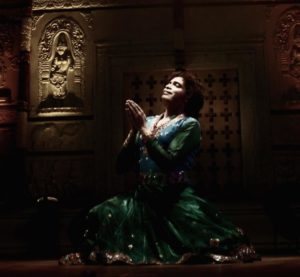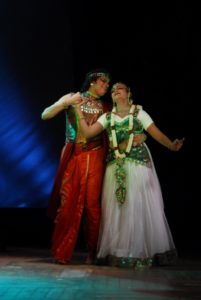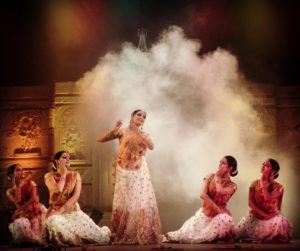KRISHNANJALI

This beauteous composition takes the form of a divine love offering to Lord “Krishna” who is depicted as the Supreme Being, an ‘avatar’ of Vishnu or the preserver. It opens with a ‘Shloka’ or an ode to Krishna as “Govinda” or the one who pervades all worlds, spreading his Power and as an “Adi Purusha” or the primeval Lord. The composition also encompasses the essence of Krishna as the “spoken one” who is referred to in several ancient vedic texts. Krishna, having several “Avatars”, is also portrayed as the compassionate, loving one who shares an immense adoration with his beloved Radha.
Performed in “Kathak” style, this piece comprises elements of pure dance such as Tukdas, Tihais and Taranas as well as pieces of expression devoted to the Lord and to episodes in the “Bhagvad Gita”. The piece closes with a dedication to the Sankrit verse of “Dharma”(or religion) and “Mangala” (or eternal positivity)
SHAKUNTALAM

This composition takes the form of a Kathak-based dance drama having been adapted from Kalidasa’s, (the great Sanskrit poet’s )”Abhijnana Shakuntalam”. Shakuntalam was the daughter of sage Vishwamitra and Apsara Menaka. Spending her childhood in the heart of Mother Nature, with the deer and the peacocks as her beloved friends, she blossoms into a young maiden possessing divine beauty. King Dushyantha, embarks upon his long hunt in the forest and catching a glimpse of Shakuntalam, is entranced by her ethereal presence. Shakuntalam too is captivated by his strength and vigor and expresses her feelings in the form of a letter. After learning that Shakuntalam is the daughter of Vishwamitra and Menaka from her, “Sakhis” or friends, Anusuya and Priyamvada, the King courts her in a royal manner. Soon their mutual love bloom into a “Gandharva Vivah” or a sacred marriage but soon Dushyantha realizing that he needs to attend to his royal duites, leaves Shakuntalam a ring on her finger and sets out to his kingdom. Shakuntalam pines in despair and longs for Dushyantha’s presence. She also learns that she is bearing a child and with the blessing of her mother, her father and her forest friends, sets out to Dushyantha’s kingdom. En route, she offers her salutation to the Ganges, however without her realization loses her ring in the river. When she enters the court, king Dushyantha fails to recognize her. Shakuntalam earnestly tells him that he is married to her and she is now bearing his child and shows him her ring finger. However the ring being missing, fails to convince Dushyantha of Shakuntala’s fidelity. Meanwhile, Shakuntala astonished that her ring is lost, frantically searches for it and pleades with Dushyantha to beleive her. Dushyantha gets enraged with Shakuntala’s outspoken falsehood calling her an “Ashudh Naari” or an impure maiden.
Shakuntalam hurt by Dushyantha’s brutal words, rises with anger and defends her womanhood, accusing him of betrayal and comparing his personality with one bearing thorns that prick the conscience. She pleads with mother nature to take her away as she feels abandoned.
The next day, King Dushyantha is approached by a fisherman who discovers Shakuntala’s ring in the belly of a fish and on seeing the ring, he is reminded of Shakuntala and realizes the mistake he made in abandoning her. He then sets out in search of her and spots a young boy playing in the forest. Dushyantha sees himself in the innocent child and Shakuntala comes out in search of the boy. The two meet again and Dushyantha implores her for forgiveness which Shakuntala lovingly offers him. They are reunited in the blissful presence of the apsaras and live happily ever after.
SHIVANJALI

This is a beautiful divine composition in the praise of Lord Shiva and his manifestation that elicits the presence of the auspicious one. It is said that all that is true, all that is good and all that is beautiful is God. The composition represents different aspects of the Lord such as the “Shiva Linga” and he is presented as the creator, preserver, destroyer, concealer and revealer. Rhythmic footwork, aesthetic movements and swift twirls manifest into a beatific worship of “Shiva” who is the “trinetra” or the three eyed, the “Neela Kanta” or the blue necked and the “Ardhanareshwara” (both man and woman).
FIRES WITHIN – Hazaro Kwahishey

The Mughlai influence of Kathak comes to life in this alluring composition, a piece woven from the great Mughal poet’s, Mirza Ghalib’s, poem. The piece is a stylized integration of traditional Kathak comprising footwork, Tukdas, Thihais, Rangmanch, Taranas and Chakkars as well as pieces of Abhinaya comprising of Urdu Ghazals coupled with elegant movements and rythmic nuances. The essence of “Hazaro Kwahishey” or a “Thousand desires” is evoked in the end when the dancer offers himself to the power of the Almighty and enters into a world of true bliss and peace.